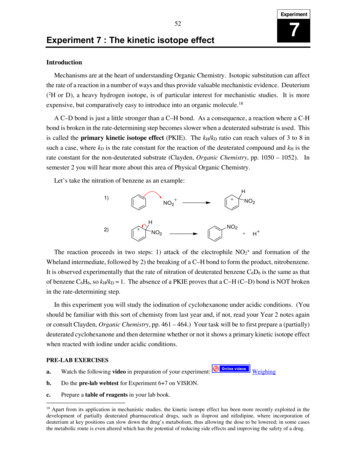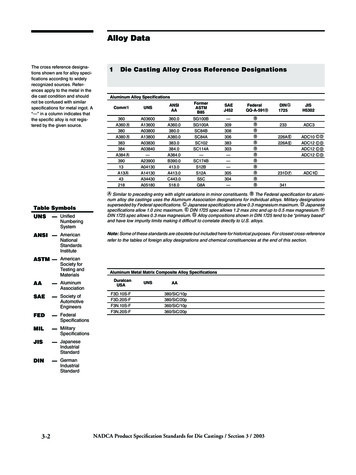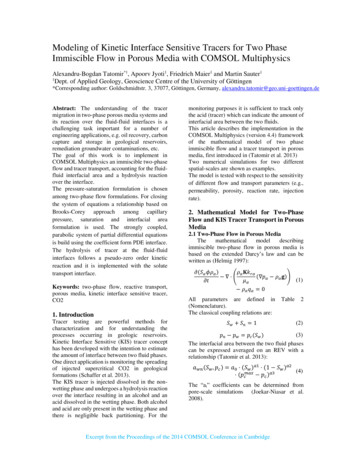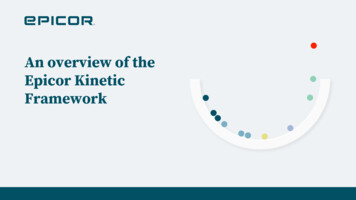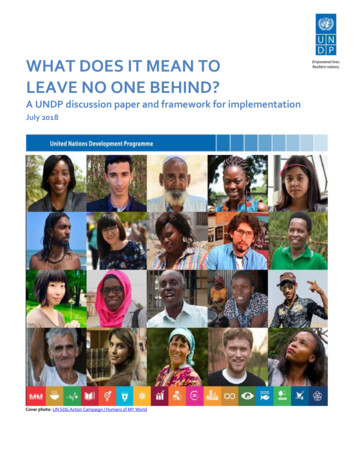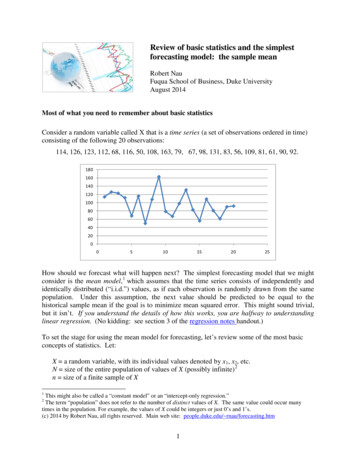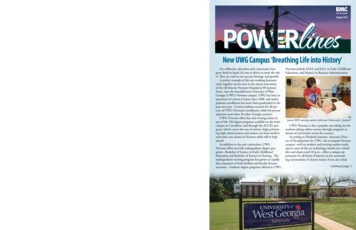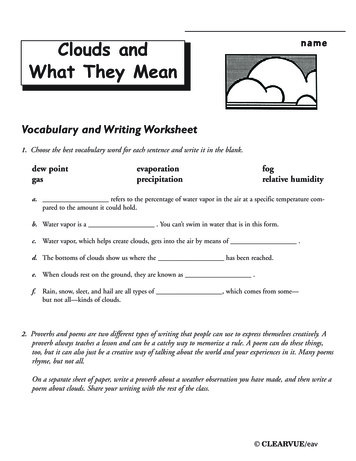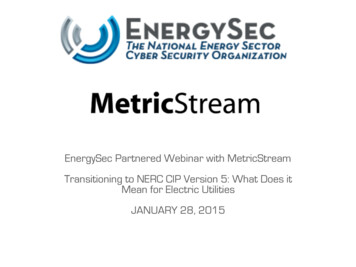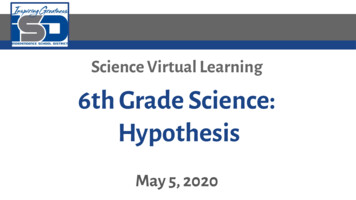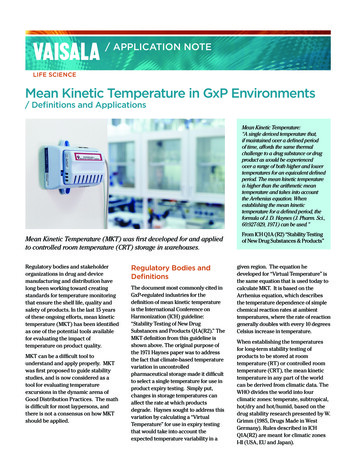
Transcription
/ APPLICATION NOTELIFE SCIENCEMean Kinetic Temperature in GxP Environments/ Definitions and ApplicationsMean Kinetic Temperature:“A single derived temperature that,if maintained over a defined periodof time, affords the same thermalchallenge to a drug substance or drugproduct as would be experiencedover a range of both higher and lowertemperatures for an equivalent definedperiod. The mean kinetic temperatureis higher than the arithmetic meantemperature and takes into accountthe Arrhenius equation. Whenestablishing the mean kinetictemperature for a defined period, theformula of J. D. Haynes (J. Pharm. Sci.,60:927-929, 1971) can be used.”Mean Kinetic Temperature (MKT) was first developed for and appliedto controlled room temperature (CRT) storage in warehouses.Regulatory bodies and stakeholderorganizations in drug and devicemanufacturing and distribution havelong been working toward creatingstandards for temperature monitoringthat ensure the shelf life, quality andsafety of products. In the last 15 yearsof these ongoing efforts, mean kinetictemperature (MKT) has been identifiedas one of the potential tools availablefor evaluating the impact oftemperature on product quality.MKT can be a difficult tool tounderstand and apply properly. MKTwas first proposed to guide stabilitystudies, and is now considered as atool for evaluating temperatureexcursions in the dynamic arena ofGood Distribution Practices. The mathis difficult for most laypersons, andthere is not a consensus on how MKTshould be applied.Regulatory Bodies andDefinitionsThe document most commonly cited inGxP-regulated industries for thedefinition of mean kinetic temperatureis the International Conference onHarmonization (ICH) guideline:“Stability Testing of New DrugSubstances and Products Q1A(R2).” TheMKT definition from this guideline isshown above. The original purpose ofthe 1971 Haynes paper was to addressthe fact that climate-based temperaturevariation in uncontrolledpharmaceutical storage made it difficultto select a single temperature for use inproduct expiry testing. Simply put,changes in storage temperatures canaffect the rate at which productsdegrade. Haynes sought to address thisvariation by calculating a “VirtualTemperature” for use in expiry testingthat would take into account theexpected temperature variability in aFrom ICH Q1A (R2) “Stability Testingof New Drug Substances & Products”given region. The equation hedeveloped for “Virtual Temperature” isthe same equation that is used today tocalculate MKT. It is based on theArrhenius equation, which describesthe temperature dependence of simplechemical reaction rates at ambienttemperatures, where the rate of reactiongenerally doubles with every 10 degreesCelsius increase in temperature.When establishing the temperaturesfor long-term stability testing ofproducts to be stored at roomtemperature (RT) or controlled roomtemperature (CRT), the mean kinetictemperature in any part of the worldcan be derived from climatic data. TheWHO divides the world into fourclimatic zones: temperate, subtropical,hot/dry and hot/humid, based on thedrug stability research presented by W.Grimm (1985, Drugs Made in WestGermany). Rules described in ICHQ1A(R2) are meant for climatic zonesI-II (USA, EU and Japan).
The description for stability testingconditions in countries located inClimatic Zones III (hot and dry) and IV(hot and humid) can be found in ICHQ1F explanatory note and in the WHOtechnical report “Annex 2: Stabilitytesting of active pharmaceuticalingredients and finishedpharmaceutical products.”In practice, products stored atcontrolled room temperature are oftentested for long-term stability insimulated laboratory conditions of 25 oreven 30 degrees (at 25 C 2 C/60% RH 5% RH or 30 C 2 C/65% RH 5% RH)for dating purposes in climatic zonesI-II, without using the exact calculatedMKT value for this particular location.These temperatures are recommendedby WHO in climatic zones I-II and(compared to the Haynes article) areprobably high. They are an example ofthe worst-case scenario ideology oftenseen in the pharmaceutical and biotechindustries. (For recommended longterm testing conditions all over theworld, see the WHO Technical ReportSeries No. 953, 2009, Annex 2, Appendix1 “Long-term stability testing conditionsas identified by WHO Member States.”)For another regulatory source thatdefines mean kinetic temperature, referalso to the FDA’s draft document:“Guidance for Industry, StabilityTesting of Drug Substances and DrugProducts.” This draft gives a muchbriefer definition: “Mean KineticTemperature (MKT) is defined as theisothermal temperature thatcorresponds to the kinetic effects of atime-temperature distribution.”And, one last definition from U. S.Pharmacopeia (USP 35 Chapter 1150 ,“Pharmaceutical Stability”): “MKT is asingle calculated temperature at whichthe total amount of degradation over aparticular period is equal to the sum ofthe individual degradations that wouldoccur at various temperatures.So, we have a basic understanding ofwhat MKT is: a weighted non-linearaverage that shows the effects oftemperature variations over time.It’s the value used when planning the long-term stability study temperatures. Thevalue includes the annual variations, e.g. lower and higher temperatures duringwinter and summer seasons. Thus, storage at a continuous temperature of 25 Cduring a real-time stability study includes the actual temperature exposure likely tobe encountered under ambient conditions throughout Europe, NA and Japan,including real-time excursions from 25 C. However, the MKT is different than otherweighted average calculations because it takes into account the non-linear effect oftemperature excursions.We can now see MKT as a mathematical tool to guide stability testing. In support ofthis view, the FDA and European Commission regard the calculation as a tool tohelp determine storage conditions, especially for shipping and storing in specificclimatic zones. (See also the European Medicines Agency document from theCommittee for Human Medicinal Products (CHMP) “Guideline on Declaration ofStorage Conditions” 2007.)MKT may also have uses beyond stability testing. In 2001 in a paper by J. Taylor of theMedicine Controls Agency, a different application for MKT was presented. Taylorargued that MKT could be applied to evaluate temperature excursions in storage ofactual products. This was a landmark change in the application of MKT, providingindustry with a tool to evaluate the quality impact of temperature excursions.Taylor’s new MKT application was widely accepted. It was a timely concept,especially in the light of the current regulatory challenges faced within GoodDistribution Practices. It should be noted that Taylor recommended caution in theapplication of MKT to evaluate temperature excursions.The MKT value is supposed to encompass the total amount of product deteriorationfor a period of time that is equivalent to the incremental deterioration that wouldoccur in separate excursions. However, the calculation is never to be used as asubstitution for control and understanding of a controlled environment. Anytemperature excursions must be rigorously investigated. A MKT value does notrelease us from this responsibility because a short-term spike still needs to beunderstood: it can indicate a larger problem, or a problem that may worsen. Rootcauses, as well as precise time and temperature data must be documented, andpreventive actions then incorporated into a CAPA (corrective actions, preventiveactions) management plan.
When & Where to UseMean Kinetic TemperatureBecause Vaisala’s Continuous MonitoringSystem software viewLinc calculatesMKT, we are often asked how to apply thecalculation. MKT was first developed andapplied to ambient storage in warehouses,and our recommendations are consistentwith this application. We recommendusing it for relatively stable, controlledroom temperature environments duringstorage applications. We do notrecommend the MKT calculation forincubators and stability chambers, whichare typically well controlled and nottypically used for storage of finishedproducts. We do not recommend MKTfor refrigerated or cold storageapplications, as the degradation resultingfrom spoilage or phase changes are notwell described by the Arrhenius equation.Nor is MKT ideal for long-term storage forthe obvious reason that in any averageover time, an increase in data points willeliminate spikes, such as a slowly climbingtemperature that may indicate anequipment breakdown. A weighted, butnon-linear average over time is best usedwhen short excursions are less likely tocause serious harm (as in CRT) and overless time. The calculation makes sense instorage and distribution applications,especially where there can be fluctuations– either because of the climatic zone, orthe season.It is not internationally agreed as towhether MKT is suitable for use inevaluating excursions duringtransportation and shipping. Forinstance, the MHRA tells us that if thewholesale authorization holder canprovide the marketing authorizationholder with details of MKT, including thetimes and extent of any temperaturedeviations, this information may assistthe marketing authorization holder informulating advice to the wholesaleauthorization holder. This clearlyindicates that the MHRA supports theuse of MKT in transportation.In contrast, the German ZLG (Zentralstelleder Lander fur Gesundheitsschutz beiArzneimitteln und Medizinprodukten/Central Authority of the German FederalLander for Health Protection RegardingMedicinal Products and Medical Devices)states that the mean kinetic temperatureis not appropriate for use in atransportation risk assessment. Again,this is because the value does not accountfor effects that may lead to irreversiblequality defects, even when certaintemperature limits established duringstability studies are exceeded only for ashort time. The MKT value also does notaccount for finer points such as thepossible formation of fissures in glassampoules and injection bottles attemperatures near freezing point.Furthermore, calculation of the MKTrequires that the temperature profiles ofall previous transports are known, butusually these data are not available.the control specifications should beunambiguous and not subject tointerpretation. It may be that CRT will fallinto disuse in quality documents andstandard operating procedures in thenear future. EMEA guidelines support thesame ideology. The use of terms such as room temperature or ambientconditions is unacceptable.Rules for Controlled RoomTemperature: Products marked with a CRTlabel should be stored atthermostatically controlledtemperature at 20 – 25 C(77 F) and a mean kinetictemperature (MKT) calculatedto be not more than 25 C withexcursions permitted to 15 –30 C (59 – 86 F). Brief exposure totemperatures up to 40 C(104 F) may be toleratedprovided the mean kinetictemperature does not exceed25 C (77 F). However, suchexposure should be minimized.Ways to Calculate MKTIn its draft article for manufacturers,repackagers, and warehouses, the FDArecommends inserting all data points intothe MKT equation directly. A minimum ofweekly high and low readings isrecommended, and more rigorousapproximations using daily highs andlows, or even more frequent temperaturereadings, are also described. Whencalculating a yearly MKT, a minimum of104 weekly high and low readings wouldbe used. The yearly MKT should becalculated from the monthly MKTcalculations. The FDA recognizes that,when the yearly MKT of a facility beginsto exceed 25 C, it may not necessarilyhave an impact on products marked witha CRT label that have been stored for lessthan one year at the time. Rather, thisvalue should be taken as a warning thatthe facility may not be under adequatecontrol.It may be worth noting that manycompanies are moving away from usingthe term CRT in their operatingprocedures and documents. Manyinstead use a specific temperature range.The USP 36 1079 Good Storage andDistribution Practices for Drug Productsdropped the use of CRT completely, aswell as describing any other specifictemperature ranges. USP now says thatThe British MedicinesAuthority MHRA gives thefollowing instructions:“MKT should not be usedto compensate for poortemperature control ofstorage facilities. It maybe applied in situationswhere control is relativelygood, but where occasionalexcursions may beencountered.”J.Taylor.“Recommendations on the Controland Monitoring of Storage andTransportation Temperatures ofMedicinal Products,”The Pharmaceutical Journal(vol 267) July 2001
oup inMKTSTDSampleTempviewLinc/Va.Temp23.6 C2522.82223.31.87HumidityviewLinc/Va.Humidity32.5 %RH3531.829N/A3.77Figure 1: MKT is often calculated incontinuous monitoring software.The MHRA has stated: “It is not possible to obtain a meaningful MKT value from daily readings of simple max / minthermometers as temperature fluctuation is not a linear function. It is noted that some data loggers and building managementsystems are capable of recording multiple temperature readings over a time period and some offer the function of calculatingthe MKT over a given time period.” The MHRA is clearly stating that continuous monitoring data can provide a moremeaningful MKT value.Regulations evolve with technology, and like many monitoring systems, Vaisala’s software viewLinc automatically calculatesMKT, using every historical data sample. Simply select the timespan you are interested in and the MKT values will appear in thesoftware window automatically. (Figure 1). Please note that mean kinetic temperature values alone should not be used indecision making when temperature excursions have occurred. It is repeatedly mentioned throughout regulatory documentsthat information about the excursion duration and extent is required, as well as an evaluation of potential effects of thetemperature excursion on product quality.Equation KeyThe MKT CalculationThe easiest and the most meaningful way to get an MKT value is by letting the dataloggers and software do the work for you. It is of course possible to do thecalculation yourself, but remember that you need an extensive amount of data anda calculation tool (e.g. Excel sheets). Otherwise the calculation can easily beoverwhelming. Furthermore, any tool used for calculation of MKT for use in GMPdecision making would require validation.The equation is:– HTK ln (– H / RT1 eR– H / RT2n– H / RTn . e,)The values used in the MKT formula are shown at right in the Equation Key. Itshould be noted that ΔH, the activation energy, describes the reaction rate for thedegradation of the active ingredients in a drug. A default value of 83.144 kJ/mol istypically used as it is a good approximation for most pharmaceutical compounds.Furthermore, it simplifies the math as it is numerically similar to the universal gasconstant. Please note that it is possible to use a different ΔH value that is specific toa given product if the information is available.If you want to see some simplified examples how to calculate the MKT, please checkUSP 35 Chapter 1160 “Pharmaceutical Calculations in Prescription Compounding.”Bear in mind that MHRA doesn’t support these kinds of calculations, nor does the FDA. H the heat of activation, whichequals 83.144 kJ per mol (defaultvalue; unless more accurateinformation is available fromexperimental studies) R universal gas constant, whichequals 8.3144 x 10-3 kJ per degreeper mol T1 the (average) temperature,in degrees Kelvin, during the firsttime point T2 the (average) temperature, indegrees Kelvin, during the secondtime point Tn the (average) temperature,in degrees Kelvin, during the nthmeasured time point; n being theamount of the measured time points TK Result in degrees Kelvin. You’llreceive the final result MKT (indegree Celsius) by doing simplesubtraction (TK – 273.15 K)
ConclusionReferencesTo summarize, we can make six basic recommendations for using mean kinetictemperature: European Medicines Agency, committeefor human medicinal products (CHMP),“Guideline on Declaration of StorageConditions:A) In the product information ofMedicinal ProductsB) For Active Substances”, CPMP/QWP/609/96/Rev 2, 2007. European Compliance Academy (ECA),GMP News 07.05.2014: “GDP Question:When to use Mean Kinetic TemperatureCalculation (MKT)?” European Compliance Academy (ECA),GMP News 22.04.2015: “GDP: Istemperature control required for eachTransport?” FDA, Draft Guidance, Stability Testing ofDrug Substances and Drug Products, 1998. ICH Harmonized Tripartite Guideline,Stability Testing of New Drug Substancesand Products Q1A(R2), 2003. ICH Q1F, Explanatory Note on theWithdrawal of ICH Q1F on the ICH Website. J. Pharm. Sci., 60:927-929, 1971. John D.Haynes. Worldwide Virtual Temperaturesfor Product Stability Testing. The Pharmaceutical Journal (vol 267),July 2001. J. Taylor. Recommendations onthe Control and Monitoring of Storageand Transportation Temperatures ofMedicinal Products. USP, Chapter 1160 , Pharmaceuticalcalculations in prescription compounding. WHO Technical Report Series No. 953,2009, Annex 2, Appendix 1 “Long-termstability testing conditions as identifiedby WHO Member States”. WHO Technical Report Series, No. 953,2009, Annex 2, Stability testing of activepharmaceutical ingredients and finishedpharmaceutical products. “Drug Stability Testing – Classification ofcountries according to climaticzone”Drugs made in Germany, by Dietz,R., Feilner, K., Gerst, F., Grimm, W. USP 35 Chapter 1150 , PharmaceuticalStability USP 36 Chapter 1079 , Good Storage andShipping Practices1. MKT should not be used to compensate for temperature excursions in anyapplication.2. When using MKT, ensure you have an adequate number of samples (time/temperature). The more samples that are included in the equation, themore the calculation will represent the actual MKT value.3. MKT should not be used in areas where temperature is not well controlled.4. Use MKT only if the storage temperature specified on the label of theproduct does not exceed 25 C.5. MKT should not be used for products that require controlled low temperature.6. Regardless of whether you use the MKT calculation or not, all temperatureexcursions should be investigated.We hope that this exploration of the history and application of MKT is useful.This topic, and its applications in distribution, will likely continue to evolve asguidance, regulations, and technologies progress.Please contact us atwww.vaisala.com/requestinfowww.vaisala.comRef. B211534EN-A Vaisala 2016Scan the code formore informationThis material is subject to copyright protection, with all copyrightsretained by Vaisala and its individual partners. All rights reserved.Any logos and/or product names are trademarks of Vaisala orits individual partners. The reproduction, transfer, distribution orstorage of information contained in this brochure in any formwithout the prior written consent of Vaisala is strictly prohibited.All specifications — technical included — are subject to changewithout notice.
Germany). Rules described in ICH Q1A(R2) are meant for climatic zones I-II (USA, EU and Japan). Mean Kinetic Temperature: “A single derived temperature that, if maintained over a defined period of time, affords the same thermal challenge to a drug substance or drug product as w
